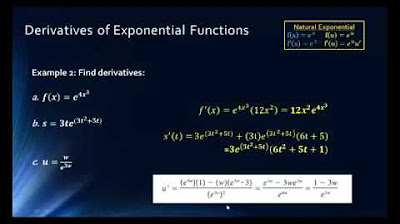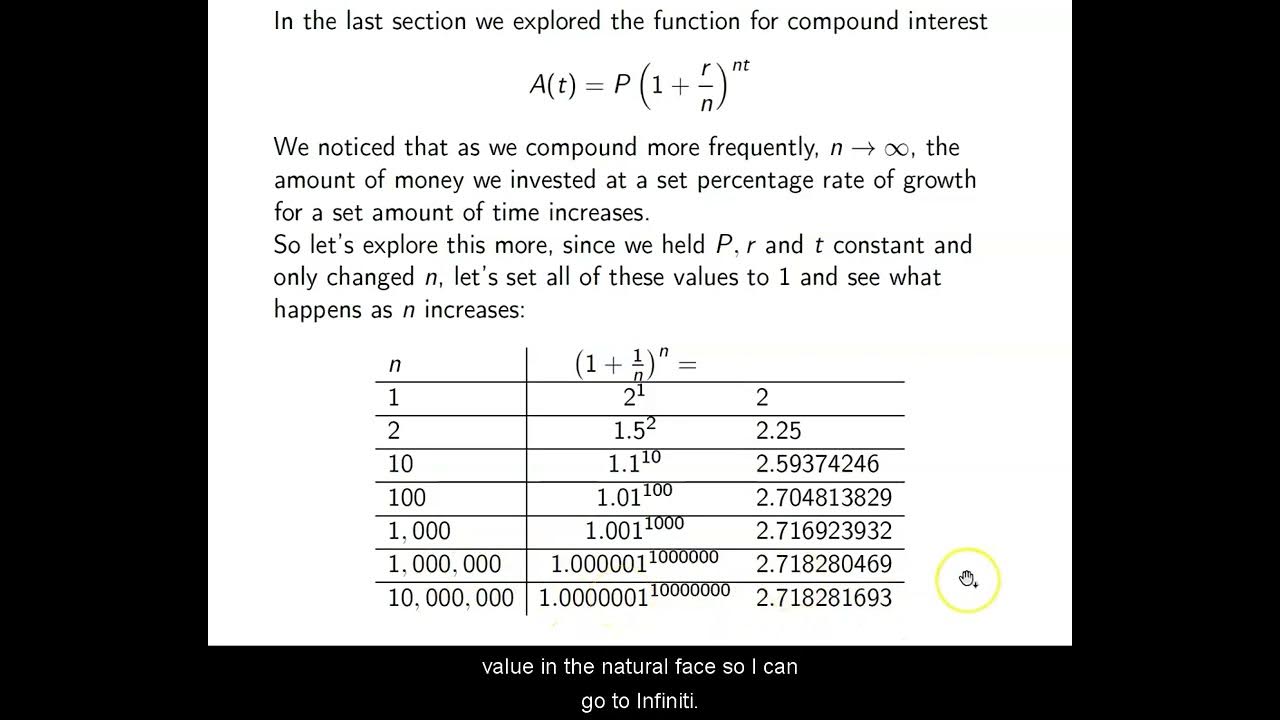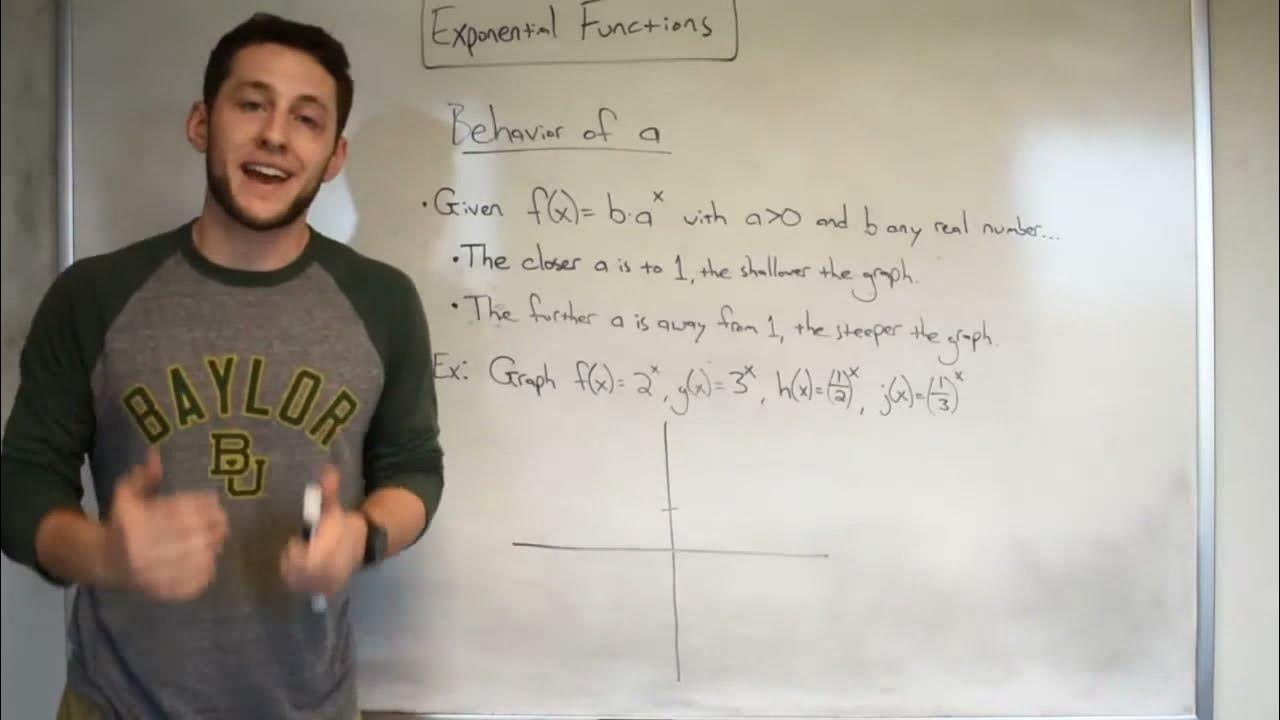Ch. 4.1 Exponential Functions
TLDRThis educational video script introduces Chapter 4 on exponential functions, defining them with a base 'a' greater than 0 and not equal to 1. It explores the behavior of exponential functions, their graphs, and rules of exponents. The script delves into the implications of different base values, such as fractional bases leading to decreasing functions and bases greater than one resulting in increasing functions. It also covers the constant function nature of a base of one and the alternating signs with negative bases. The application of exponential functions to compound interest is explained, illustrating the formula and its components, and demonstrates how the frequency of compounding affects the growth of an investment over time.
Takeaways
- 📚 The class is starting Chapter 4, focusing on exponential functions, their graphs, applications, and limits.
- 🔢 An exponential function is defined with a base 'a' where 'a' is a real positive value, excluding zero and one, and 'x' can be any real number.
- 📉 When 'a' is between 0 and 1, the function decreases exponentially, and when 'a' is greater than 1, it increases exponentially.
- 🚫 The base 'a' cannot be one because any number to the power of one equals one, resulting in a constant function.
- 🔄 If the base 'a' were negative, the function would alternate between positive and negative values, violating the continuity of the function.
- 📈 The y-intercept of an exponential function in the form of \( a^x \) is always one, as anything to the power of zero equals one.
- 📊 The function never actually reaches zero, but can get very close to it, depending on whether it's increasing or decreasing.
- 🔑 Understanding the rules of exponents is crucial for working with exponential functions, especially when multiplying or dividing terms with the same base.
- 💰 Compound interest is a key application of exponential functions, calculated using the formula \( A = P(1 + \frac{r}{n})^{nt} \).
- 📈 The frequency of compounding affects the growth of investment, with more frequent compounding leading to higher returns over time.
- 💡 The limit of compound interest as the number of times per year ('n') approaches infinity does not result in infinite growth but a finite value.
Q & A
What is the main focus of Chapter 4 in the transcript?
-Chapter 4 focuses on exponential functions, including analyzing their graphs, applying them in different situations, and examining related limits.
What is the definition of an exponential function as described in the transcript?
-An exponential function is defined as having a base 'a', where 'a' is a real positive value, excluding zero and one, with 'x' being any real number and the function taking the form of 'a' raised to the power of 'x'.
Why are exponential functions not defined for a base of one?
-An exponential function with a base of one would always equal one for any real number 'x', making it a constant function rather than an exponential one.
What happens when the base 'a' of an exponential function is between zero and one?
-When the base 'a' is between zero and one, the function is exponentially decreasing.
What is the behavior of an exponential function when the base 'a' is larger than one?
-When the base 'a' is larger than one, the function is exponentially increasing.
Why are negative bases not considered for exponential functions in this context?
-Negative bases would result in the function alternating between positive and negative values as 'x' changes, making the function discontinuous and not fitting the standard form of exponential functions discussed in the script.
What is the significance of the y-intercept in exponential functions of the form f(x) = a^x?
-The y-intercept is always one because any non-zero base raised to the power of zero equals one, which is the case when x equals zero.
How does the presence of a coefficient in front of the exponential function affect the y-intercept?
-A coefficient in front of the exponential function, such as in f(x) = 3*2^x, scales the function vertically, changing the y-intercept from the base value of one.
What is the formula for compound interest as discussed in the transcript?
-The formula for compound interest is A = P(1 + r/n)^(nt), where P is the principal amount, r is the annual interest rate, n is the number of times interest is compounded per year, and t is the time in years.
How does the frequency of compounding affect the amount of money earned from an investment?
-The more frequently the interest is compounded, the more money is earned over time, as the interest is added to the principal more often, allowing it to accumulate at a faster rate.
What is the practical implication of the limit of compounding as the number of times per year approaches infinity?
-The practical implication is that while increasing the frequency of compounding increases the earnings, the value does not go to infinity; it reaches a stable limit as the compounding frequency becomes very large.
Outlines
📚 Introduction to Exponential Functions
This paragraph introduces Chapter 4 on exponential functions, focusing on their definition, properties, and applications. The base 'a' of an exponential function must be a positive real number, excluding one and zero. The exponent 'x' can be any real number. The teacher emphasizes the importance of understanding the rules of exponents from Chapter 1 and discusses the implications of different values of 'a' on the function's behavior, such as increasing or decreasing exponentially. The concept of a function never reaching zero is highlighted, and the teacher uses graphing to illustrate the behavior of exponential functions with different bases.
📈 Graphing Exponential Functions and Their Transformations
The second paragraph delves into the graphical representation of exponential functions, demonstrating how the value of 'a' affects the shape of the graph. The teacher explains that when 'a' is between zero and one, the function decreases exponentially, while for 'a' greater than one, it increases exponentially. The constant function '1^x' is shown as a special case. The effects of negative exponents and the reflection of the graph across the y-axis are also discussed, along with an example of determining the equation of an exponential function given a graph and a point.
💰 Applications of Exponential Functions: Compound Interest
This paragraph explores the application of exponential functions in the context of compound interest, a financial concept where interest is added to the principal periodically. The formula for compound interest is presented, and the teacher explains the variables involved, such as the principal amount 'p', the interest rate 'r', the number of times interest is compounded per year 'n', and the time 't'. The importance of compounding frequency on the growth of investment is highlighted, and the teacher illustrates this with an example of a money market account investment.
🔢 Example Calculation of Compound Interest Over Time
The teacher provides a step-by-step example of calculating the growth of an investment over five years with a 0.5% annual interest rate, compounded once a year. The process involves converting the interest rate to a decimal, applying the compound interest formula, and simplifying the equation to find the final amount. The teacher then compares this to the scenario where the interest is compounded monthly and daily, showing the slight differences in the final amounts due to the increased compounding frequency.
📊 Impact of Compounding Frequency on Investment Growth
The final paragraph summarizes the effect of compounding frequency on the growth of an investment. The teacher demonstrates that as the number of times interest is compounded per year increases, the total amount earned also increases, but at a diminishing rate. The comparison between annual, monthly, and daily compounding is reiterated, with the teacher emphasizing the practical implications of compounding frequency on financial investments.
Mindmap
Keywords
💡Exponential Functions
💡Base 'a'
💡Y-Intercept
💡Compound Interest
💡Exponential Growth/Decay
💡Rules of Exponents
💡Continuous Function
💡Graph of Exponential Functions
💡Limit
💡Transformation of Functions
Highlights
Introduction to Chapter 4 on exponential functions.
Definition of an exponential function with base 'a' where 'a' is a real positive value excluding one.
Explanation of why the base 'a' cannot be zero or one.
The role of 'x' as a real number in the function with no restrictions.
Importance of understanding the rules of exponents for exponential functions.
Behavior of exponential functions when the base 'a' is between zero and one versus larger than one.
Implications of a negative base in an exponential function leading to alternating signs.
Demonstration of exponential functions with decimal bases and their increasing or decreasing nature.
The constant function nature of an exponential function with a base of one.
Analysis of the y-intercept of exponential functions and its constant value.
Transformation of exponential functions with a change in the coefficient.
Graphs illustrating the difference between increasing and decreasing exponential functions.
Characteristic of exponential functions never actually reaching zero despite getting close.
Transformation of an increasing exponential function by using a negative exponent.
Example problem solving to find the equation of an exponential function given a graph and a point.
Application of exponential functions in the context of compound interest.
Formula for compound interest and its components: principal, rate, time, and compounding frequency.
Impact of compounding frequency on the growth of investment over time.
Limit of investment growth as compounding frequency approaches infinity.
Example calculation of investment growth with different compounding periods: yearly, monthly, and daily.
Conclusion on the effect of compounding frequency on the final amount of an investment after a fixed period.
Transcripts
Browse More Related Video

Graphing Exponential Functions with Transformations (Precalculus -College Algebra 53)

Math1325 Lecture 11 2 - Derivatives of Exponential

Ch. 4.2 The Natural Exponential Function

Business Calculus - Math 1329 - Section 4.1 - Exponential Functions and Continuous Compounding

Exponential Functions!

Graphs of Exponential Functions (Precalculus - College Algebra 52)
5.0 / 5 (0 votes)
Thanks for rating: